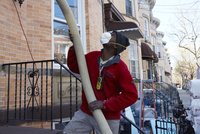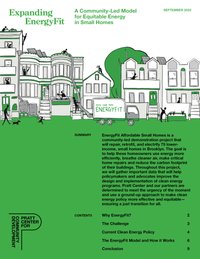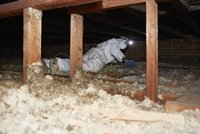
EnergyFit Affordable Small Homes is an ongoing energy equity research effort. It is the culmination of a decade of Pratt Center research and advocacy, focused on ensuring NYC’s low-income residents of 1–4 family buildings benefit from the clean energy transition. This demonstration project streamlines prior learnings and new policies from typically disparate home repair, energy efficiency retrofit, and electrification measures into a holistic model. The goal is to model a program design solution, utilizing robust in-the-field data collection and grounded in local community-informed design, to show that more equitable and effective policy and programmatic offerings in NYC can improve these communities’ access to clean energy.
BACKGROUND
New York City’s 1–4 family building stock is a prime source of naturally-occurring affordable housing. It has been a vital tool for Black and brown New Yorkers to build wealth. There are over 863,000 of these buildings in NYC and ⅔ of these are located in low- and moderate-income communities primarily housing people of color. The majority of these buildings are over 100 years old and have ongoing maintenance needs related to their age. Almost all of these buildings are using fossil fuels for heating and cooking, increasing the risk of asthma and other respiratory health issues. And the energy burden (the percentage of a household’s income spent on energy bills) is significantly higher for low-income households of color.
New York State and New York City’s ambitious decarbonization goals and recent federal measures present an incredible opportunity to solve the problems of poor indoor air quality, energy burden, and greenhouse gas emissions in NYC’s small buildings—if program design is done right.
While the New York State Energy Research and Development Authority (NYSERDA) offers a program for low income households looking to retrofit their homes, a Pratt Center analysis of publicly available data shows that less than 7% of NYC’s 1–4 family market participates in these offerings. Thus, it’s imperative that the design of any incentive or support programs is done with adequate information about on-the-ground conditions for homeowners, renters, contractors, and local CBOs who administer these programs.
EnergyFit Affordable Small Homes demonstrates an opportunity to do just that. With the increasing acknowledgement in the policy sphere of the equity needs within the clean energy transition, such as the passage of the Climate Leadership and Community Protection Act (CLCPA), the moment for modeling an equity focused program is now. While federal and state expand commitments to decarbonization and the private sector accelerates its interest in electrification — EnergyFit is vital for providing insights into what works and what does not when serving LMI households.
THE ENERGYFIT MODEL
EnergyFit will repair, retrofit, and electrify 75 lower-income, small homes in Brooklyn—helping these homeowners use energy more efficiently, breathe cleaner air, make critical home repairs and reduce the carbon footprint of their buildings.

Downloads
It will also generate crucial data about the true implementation costs and benefits of clean energy upgrades in NYC’s two and three-family market, just as funding from the Inflation Reduction Act starts to flow to New York. To learn more about what data we are collecting, why it’s needed, and how this can improve government policy and program design, read our newest paper Expanding EnergyFit: A Community-Led Model for Equitable Energy in Small Homes.

THE PLAN
EnergyFit is currently accepting homeowner applicants for over-the-phone assessments, and in-home assessments. For those homes that meet the program criteria, the project will offer a three-tiered model of efficiency and electrification packages focused on:
Repairing any deferred maintenance issues that prohibit retrofits.
Improving these homes' energy efficiency through the implementation of a specific set of energy conservation measures including attic insulation.
Updating household electrical infrastructure necessary to electrify the building, changing out gas stoves for induction stoves, and upgrading gas-fueled domestic hot water heaters to electric.
Each building will receive one of the EnergyFit packages, and Pratt Center will monitor program impacts that will continue to build expertise on ways to affordably simplify and streamline repair, retrofit, and electrification processes. Findings from this demonstration project will be available for policy makers and practitioners in the field to utilize in improving program offerings. Pratt Center will continue advocating for healthier, energy efficient homes for all New Yorkers, as we have over the past 15 years.